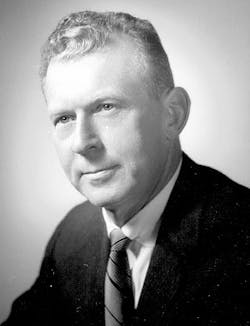My father was an artist — an artist of the business deal. He was a virtuoso. Most of his deals, but not all, were profitable. Many turned out quite ordinary. But some were beautiful.
As an art form, the business deal is fluid, pliable, liable to shift, even fall to pieces, at any moment. It resembles music in that its structure takes place over time. Unlike music, it cannot be judged until it is completed, when it can be contemplated as a finished work.
The art of the business deal is the buying and selling of property — it could be a dozen cartons of three-inch ceramic insulators (Electra Supply Co., the family business, was an electrical wholesaler) or one hundred acres of vacant land (real estate speculation became my father’s sideline). An ordinary deal is an amorphous chain of activity which, when completed, falls into one of a score or so of common, boring shapes. An artist molds the deal into something unique. If he’s lucky, or a virtuoso, like my father, it can turn out to be something beautiful.
It’s not uncommon for someone involved in a deal to want to put his personal imprint on it — signing the deal with a special Mont Blanc pen, or celebrating its completion at a particular French restaurant. Real estate developers can have the pleasure of naming streets after their children or mythical characters who have caught their fancy.
But the artistic impulse is — despite what passes for common wisdom these days — more profound than simple self-expression. It’s an urge to create something beyond the self, something that stands alone — a new and unique thing, ideally a beautiful thing.
My father even had an audience, men who considered themselves connoisseurs of the deal. “Beautiful deal, Nate, and it took guts.” “I wish I knew how you do it.” “That deal, Nate — it took real vision.”
Those weren’t tributes to the profits made on deals, but expressions of admiration for the deals themselves, for how my father had shaped them into things that were a pleasure to behold.
As my father’s skills increased, he began to look for larger deals, deals which, when completed, would have a scope, a distinction, that could not be achieved with small, everyday deals. He found one in the Navy SE cable deal.
Somewhere in the news magazines, newspaper business pages and trade publications that my father assiduously read, he had come across an analysis of the price of copper that concluded that it was inexplicably low and was bound to take a sharp upturn. The article made sense to him, and he began to look for a deal based on low copper prices. Eventually he found one.
It began with an advertisement in Electrical World.
The War Assets Administration (WAA), charged with selling off surplus military supplies after World War II, ran ads in trade magazines and local newspapers, touting everything from toilet paper to Jeeps. In 1947 it advertised for sale, from the Scotia naval depot near Schenectady, N.Y., about 50,000 feet of 10/2 AWG SE cable in 1,000-foot reels.
It was an awful lot of cable. In a good year, Electra might sell the equivalent of one of those reels. Because there was so much of it and because it was a large gauge, the WAA’s minimum bid for the cable was far below the market price which, my father was convinced, itself was too low.
The deal would not only be a large deal, but had the potential for grandeur. It was a deal with the United States Navy, which gave it a certain classiness, a gloss that was one of the distinctions of my father’s art. Furthermore, the heart of the deal — the SE cable — was stored less than one hundred miles away. That made things easier practically, but most importantly it meant that the people he would be dealing with would be nearby, making it easier for him to form personal relationships with them.
The medium of the business deal is not, as one might think, money, but personal relationships. For an artist, the people involved in the deal are like the colors on his palette. The skill required is not — as it is in ordinary business deals — sizing up the other players and playing to their weaknesses, but finding their strengths and working with those, just as a painter appreciates, even loves, the paint with which he works.
There surely were other bidders for the cable. They would have received cut-and-dried bidding forms and completing this paperwork would have been their first step. My father’s first step, once he decided to go after the deal, was to make sure he would get it. He could have done this, of course, by placing a winningly high bid for the cable. With his hunch about the price of copper (which turned out to be correct), the deal still would have been financially successful. But it would not have been a beautiful deal, just an ordinary bit of speculation, even a bit vulgar.
Instead, my father phoned Scotia and made a date to go up there, on the pretext of wanting to eyeball the cable. What he really wanted to do was meet the men involved. Once he was personally involved, the deal would almost surely be his for the asking. His poise, his style, his intelligence were irresistible, especially in the wheeling and dealing world of the 1940’s and 1950’s. Sellers and buyers, once they met my father, were reluctant to give deals to anyone else simply because that would mean giving up the pleasure of associating with him.
My father, Nathan Reifler, was about 6-feet tall, with fair, curly hair — and handsome. In his youth he was often mistaken for singer Rudy Vallee. His work clothes were a three-piece suit, in light gray or subdued beige, a white, or lightly tinted, shirt, and a Countess Mara tie or a bow tie. He was smart, quick-thinking, and sharp-witted, but he used these qualities as tools, never weapons. His patrician cast came naturally to him; it was not phony, but neither was it unconscious. Like many artists, he was aware of his persona and cultivated it. He was aware also that it could be intimidating and knew just how and when to forestall that effect with a bit of slang, a dirty joke or a slap on the back.
My father liked just about everyone he met. He might change his mind about someone, but it always would be because of something that was said or done, never because of who or what someone was. A boisterous, florid Jewish land developer from Long Island and a prim, fastidious banker with a name from the Mayflower, each considered him a close friend. And he was.
The three bureaucrats who awaited him in Scotia probably were expecting to meet a stereotype of an upstate businessman, perhaps a dumpy guy in a rumpled suit, with a five o’clock shadow and a bit of his lunch on his tie. It was an old story for my father: The fact that they were pleasantly nonplused, along with my father’s negotiating skills, put the Navy SE cable deal squarely in his pocket.
He also made three new friends. He played golf with one of them. One of the men was a ham radio enthusiast, and my father was genuinely fascinated. When one came down to Poughkeepsie, N.Y., he took him out to lunch — not to the Nelson House Hotel or Smith Brothers, a high-ceilinged, cloth napkin 19th century holdover, but to the Greek diner around the corner from Electra Supply, where my father was treated like family because he had bothered to learn a few words of Greek.
Soon after the deal was signed, and sealed with a deposit, one of the Navy men mentioned that he had underestimated the cost of delivery and was going to go over budget. According to the contract, delivery of the cable was the seller’s responsibility, but my father offered Electra Supply’s warehouse staff, on Electra Supply’s time, to help defray those costs. It meant Electra Supply would have to sell another one or two reels of cable before breaking even.
The gratuitous offer can be attributed in part to my father’s natural generosity and in part to his shrewd foresightedness. But the primary impulse was that it added an interesting facet, a touch of his personal style, a bit of warm ornamentation, to what he hoped would turn out to be a grand and beautiful deal.
Not long after the cable was delivered and the huge reels were stacked in Electra Supply’s warehouse, the aisles between them just wide enough for the forklift, copper prices skyrocketed. There was no electrical cable shortage, but the manufacturer’s prices for 10/2 SE rose far above what my father had paid. Reel by reel, the stock of surplus cable went out the door. But, like any large artwork, the Navy SE cable deal took years to come to fruition.
In the early 1950’s, construction began on a six-mile tunnel, the Neversink Aqueduct, connecting the Neversink Reservoir, which was nearing completion after a decade of work, with the West Delaware Aqueduct. While under construction, the tunnel would require electrification. Six miles of cable would just about clear out the rest of Electra Supply’s stock of the 10/2 SE. The final shape of the deal became clear.
The Neversink Aqueduct was a project of the New York City Water Board. The electrical gear assumedly would be supplied by Graybar Electric Co. To call Graybar a Goliath to Electra’s David would be to minimize the difference. If you exit Grand Central on Lexington Avenue, you walk through The Graybar Building. It wasn’t that Graybar had a contract for the Neversink Tunnel; at that time Graybar simply was the go-to supplier for any humungous project in the Northeast.
Like any good artist, my father knew his limitations. He had been able to approach the handful of men at the Scotia Depot, but the New York City Water Department was a monolithic bureaucracy beyond his power of persuasion. He waited until construction of the tunnel began, waited until there were managers, engineers, foremen, in shirtsleeves, working in trailers on the site. Then he made the 30-mile drive to Neversink.
In one afternoon Electra Supply became the project’s default electrical supplier. It wasn’t a hard sell. Whatever Graybar could supply, Electra could supply too; an Electra truck went out that way twice a week, and anything they needed urgently could be delivered within a few hours; instead of a low-level Graybar salesman, they would be dealing with the boss himself, my father in all his amiable glory.
He did not mention the 10/2 SE to the tunnelers. He bided his time and, sure enough, someone on the project mentioned to him that they would be using six miles of cable, which they planned to buy directly from a manufacturer. Electra could supply it below any manufacturer’s price, my father announced. Nor was he coy about how Electra happened to have a warehouse full of SE cable: It was a good story, my father was a good story teller, and who wouldn’t want to be part of such a beautiful deal?
The profit he made was important, in the same way that it is important to a sculptor that his creation does not topple over or collapse. What really counted, though, was the deal itself, the skill and inspiration that had gone into it and what it looked like when it was finished. It was a lovely deal.
Samuel Reifler is a fiction writer who once worked as an intern for Electrical Wholesaling in the 1950s. His grandfather, Nathan Reifler, founded Electra Supply Co., in Poughkeepsie, N.Y., over 100 years ago. Electra Supply Co. was purchased by WESCO some years ago.










